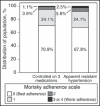Prevalence and correlates of low medication adherence in apparent treatment-resistant hypertension
- PMID: 23031147
- PMCID: PMC3464920
- DOI: 10.1111/j.1751-7176.2012.00690.x
Prevalence and correlates of low medication adherence in apparent treatment-resistant hypertension
Erratum in
-
Corrigendum.J Clin Hypertens (Greenwich). 2018 Jun;20(6):1080. doi: 10.1111/jch.13317. Epub 2018 May 25. J Clin Hypertens (Greenwich). 2018. PMID: 29902366 Free PMC article. No abstract available.
Abstract
Low medication adherence may explain part of the high prevalence of apparent treatment-resistant hypertension (aTRH). The authors assessed medication adherence and aTRH among 4026 participants taking ≥ 3 classes of antihypertensive medication in the population-based Reasons for Geographic and Racial Differences in Stroke (REGARDS) trial using the 4-item Morisky Medication Adherence Scale (MMAS). Low adherence was defined as an MMAS score ≥ 2. Overall, 66% of participants taking ≥ 3 classes of antihypertensive medication had aTRH. Perfect adherence on the MMAS was reported by 67.8% and 70.9% of participants with and without aTRH, respectively. Low adherence was present among 8.1% of participants with aTRH and 5.0% of those without aTRH (P<.001). Among those with aTRH, female sex, residence outside the US stroke belt or stroke buckle, physical inactivity, elevated depressive symptoms, and a history of coronary heart disease were associated with low adherence. In the current study, a small percentage of participants with aTRH had low adherence.
© 2012 Wiley Periodicals, Inc.
Figures


References
-
- Calhoun DA, Jones D, Textor S, et al. Resistant hypertension: diagnosis, evaluation, and treatment: a scientific statement from the American Heart Association Professional Education Committee of the Council for High Blood Pressure Research. Circulation. 2008;117:e510–e526. - PubMed
-
- Mazzaglia G, Mantovani LG, Sturkenboom MC, et al. Patterns of persistence with antihypertensive medications in newly diagnosed hypertensive patients in Italy: a retrospective cohort study in primary care. J Hypertens. 2005;23:2093–2100. - PubMed
-
- Van Wijk BL, Klungel OH, Heerdink ER, de Boer A. Rate and determinants of 10‐year persistence with antihypertensive drugs. J Hypertens. 2005;23:2101–2107. - PubMed
Publication types
MeSH terms
Substances
Grants and funding
LinkOut - more resources
Full Text Sources
Medical

